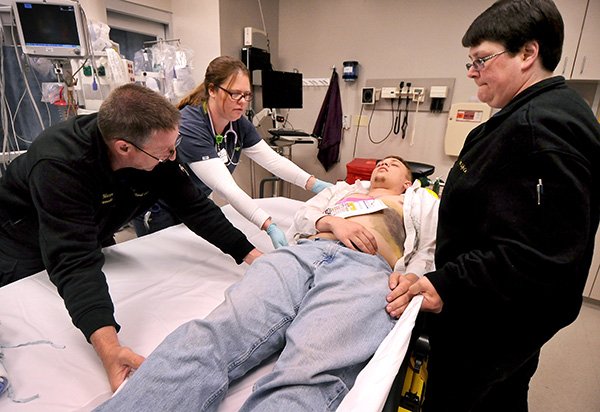Staff members and visitors at Mercy Hospital Northwest Arkansas in Rogers quieted as a woman announced a tornado warning through the hospital’s speaker system about 8:30 a.m. Tuesday. The announcement was followed with the statement, “This is a drill.”
The announcement marked the start of a regionwide emergency drill that included about 13 hospitals and medical facilities in Gravette, Berryville, Siloam Springs, Rogers, Bentonville, Harrison, Eureka Springs, Springdale and Fayetteville. Area fire and ambulance servicesalso participated in the drill.
The drill was coordinated by members of the region’s Health Care Preparedness Program. The program is funded by federal grants funneled through the Arkansas Department of Health.
“The HPP distributes federal funds to health-care facilities in the state to help them plan, prepare, train and exercise for disasters and public health emergencies that may impact their facilities,” Kerry Krell, spokesman for the department, has previously said. She said $2.1 million was directed to health-care coalitions in the state this year.
Steve Oler, co-leader of the Northwest Arkansas preparedness program, said hospitals involved in the drill had very little information about it beforehand.
Hospital teams were given several sealed envelopes before the exercise, Oler said. The hospital teams were asked to open an envelope periodically throughout the exercise as they entered different phases of the drill.
All of the hospitals were alerted - via the envelopes - that large tornadoes were sighted on the ground in Washington, Benton, Madison, Carroll, Boone and Newton counties, Oler said. The scenarios included people injured from structural damage at businesses or public facilities, he said.
About 20 minutes after learning of the tornadoes, Candy Alfano, director of nursing for Mercy, opened another envelope. She read aloud to officials working in the hospital’s disaster control center on an administrative floor of the hospital.
“We have inoperative land-line service,” Alfano said. “Cell service is poor, therefore we no longer have our phones. Natural gas has been shut down due to a large amount of gas leaks.”
Alfano instructed that the hospital would switch to diesel fuel for power and toradios as the primary communication. Also, she said a team would be stationed outside the command-center door to run messages to other parts of the hospital.
In a room down the hall, a team organized the hospital-staff labor pool. Employees reporting in at the hospital during a disaster are required to register in the labor pool room, said Martine Pollard, spokesman for Mercy. She said employees from all departments of the hospital pitch in to help doctors and nurses during disasters.
Pollard said 40-50 employees at the hospital participated in Tuesday’s drill.
Brenda Chase, Mercy’s chief operating officer, was working in the command center during the drill. She said the command center’s job is to evaluate the hospital’s ability to treat the disaster’s patients.
“We are looking for our capacity in our intensive-care unit and our operating room,” Chase said. “We might cancel noncritical surgeries. When we receive that call, it is all about what resources are available for those patients.”
Chase said there is constant communication with people in the emergency room who are assessing the needs of patients and determining their treatment priorities. She said that helps the command center decide what resources are needed.Resources could include food, power, backup generators or sterilization equipment.
Just after 9 a.m., Thomas Alley, with the hospital’s facilities department, was helping coordinate patient intake in the hospital’s emergency room. He helped organize personnel stationed at three emergency-room entrances. The employees would systematically check in and assess each patient who arrived. He said that during large disasters, more than one entrance to the emergency room is needed.
“Patients will come in any way they can,” Alley said.
Northwest Health System’s Springdale and Bentonville hospitals also participated in the drill. One emergency scenario involved the Springdale hospital receiving structural damage to one of its patient towers.
Bruce Waldon, chief medical officer, said the scenario made the experience at Northwest Health System unique. “It created a challenge for us,” he said. “We also had to go through patient evacuation drills.”
Mock patients were moved from the towerdown stairways on a special stretcher that resembles a sled, Waldon said.
Tom Pearson, captain for the Springdale Fire Department, said the situation also promoted teamwork between the staffs of the hospital and the Fire Department.
“What we have learned is a working communication with the hospital,” Pearson said.
In this case, part of the hospital - the tower - was the disaster scene. First responders and hospital staff members had to work together in assessing the needs of the injured and then transporting them to the emergency room.
Oler said the Health Care Preparedness Program holds a training drill every year to keep hospitals prepared.
“Like any business, we get new employees,” Oler said. “It gives them [new workers] a chance to participate in response to disasters. This way we can treat patients appropriately.”
Krell said the region’s health-care coalition has received $281,960 for emergency preparedness through the federal grant process. The funds are awarded annually .-
Northwest Arkansas, Pages 7 on 04/16/2014

